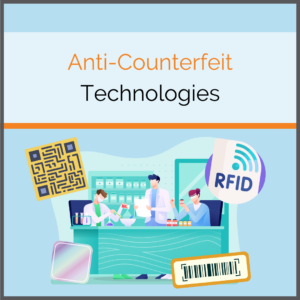
Product counterfeiting is a well-known problem, whether it involves designer fashion, electronics, or even food. The circulation of these counterfeits initially means financial damage for the manufacturers. When it comes to medicines, there is an additional health risk for patients. According to a study published in 2020, it is estimated that between 72,000 to 169,000 children die annually from pneumonia after receiving counterfeit medicines. Additionally, there are approximately 116,000 deaths due to counterfeit anti-malaria drugs. Therefore, efforts are being made worldwide to make product counterfeiting easily identifiable through appropriate laws and anti-counterfeiting technologies, in order to remove them from the supply chain.
The WHO estimates that 10% of the medicines circulating in the Global South are counterfeit. However, there are several methods to combat these counterfeit drugs. In this article, we discuss which anti-counterfeiting technologies are common, how product counterfeiting is countered in the pharmaceutical industry, and what impact the supply chain law can have.
Product Counterfeiting in the Pharmaceutical Industry
Laws to combat product counterfeiting are well-established in the pharmaceutical industry. In the European Union, there is the Falsified Medicine Directive (EU-FMD), and the Drug Supply Chain Security Act (DSCSA) in the USA. These regulations aim to make supply chains safer and prevent counterfeit medicines. However, the EU and the USA are high-income regions. The biggest problems with counterfeit medicines exist in low-income countries. Introducing the necessary regulations requires a lot of resources many countries do not have access to. A significant step towards combating counterfeiting is the TRVST system, which aims to restrict the trade of counterfeit medicines in many countries. Additionally, countries with regulations against counterfeit medicines are growing.
What Are Common Anti-Counterfeiting Technologies?
To ensure the integrity of products and strengthen patient trust, anti-counterfeiting technologies are essential. The most common methods include serialization, holographic labels, RFID, and QR codes.
- Serialization enables the unique identification and tracking of each individual product along the entire supply chain. This helps to quickly identify and remove counterfeit products from circulation.
- Holographic labels provide a visual method of authentication that is difficult to counterfeit. These labels contain special patterns or colors that are only visible under certain lighting conditions, making counterfeiting significantly more difficult.
- RFID technology uses radio waves to wirelessly transmit information and track products in real-time. This is particularly useful in complex supply chains as it allows continuous monitoring.
- QR codes, printed on packaging, can be scanned with a smartphone to provide details about the product’s origin and authenticity. These codes offer a simple and accessible way for consumers to verify the authenticity of a product.
- Tamper-evident labels show visible signs of tampering when removed or altered and are often used as an additional security layer.
These technologies help combat counterfeiting and ensure product safety by creating barriers that are too complex to counterfeit.
What Does the Future of Anti-Counterfeiting Technologies Look Like?
The future of anti-counterfeiting technologies promises exciting developments that will further improve the safety and authenticity of products. One of the most promising technologies is the integration of artificial intelligence (AI) and machine learning. They can enable the real-time detection and analysis of anomalies and potential counterfeits. Additionally, the use of the Internet of Things (IoT) will continue to increase. Products can be continuously monitored by equipping them with sensors that are read by IoT devices. They transmit and collect real-time data about their location and condition. This data is sent to central systems that analyze and monitor it to ensure the integrity and authenticity of the products.
Advances in RFID technology and the introduction of 5G networks will further improve real-time communication and tracking. The development of tamper-evident labels and packaging will also progress, making it even more difficult for counterfeiters. Finally, the increasing spread of digital product passports and the use of blockchain technology will further enhance transparency and traceability along the entire supply chain.
How Can the Supply Chain Law Help?
The EU Supply Chain Law can significantly support the establishment of anti-counterfeiting technologies by requiring companies to make their supply chains more transparent and secure. Due to the strict due diligence requirements, companies must ensure that their products remain authentic and intact along the entire supply chain. This promotes the use of technologies such as serialization, RFID, and tamper-evident labels to verify the origin and authenticity of products. Additionally, the law encourages companies to implement modern track & trace systems that enable seamless tracking and real-time monitoring. These measures not only help combat counterfeiting but also strengthen consumer trust and meet the legal requirements for supply chain transparency and integrity.
How Can tracekey Support You?
We support pharmaceutical companies in meeting various track & trace requirements using anti-counterfeiting technologies such as serialization. Our cloud-based solutions also enable quick and easy implementation. Customers receive long-term support from us in complying with global regulations, including the EU-FMD and the DSCSA. However, we also offer solutions for the serialization requirements of Bahrain, Indonesia, Kyrgyzstan, Kazakhstan, Uzbekistan, the United Arab Emirates, and many other countries. This ensures that our customers are always compliant.